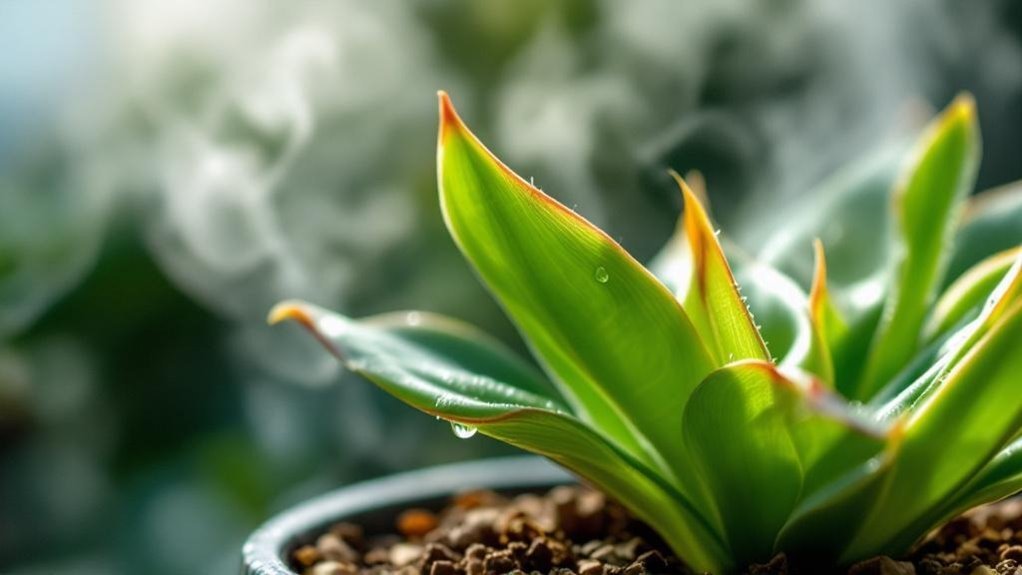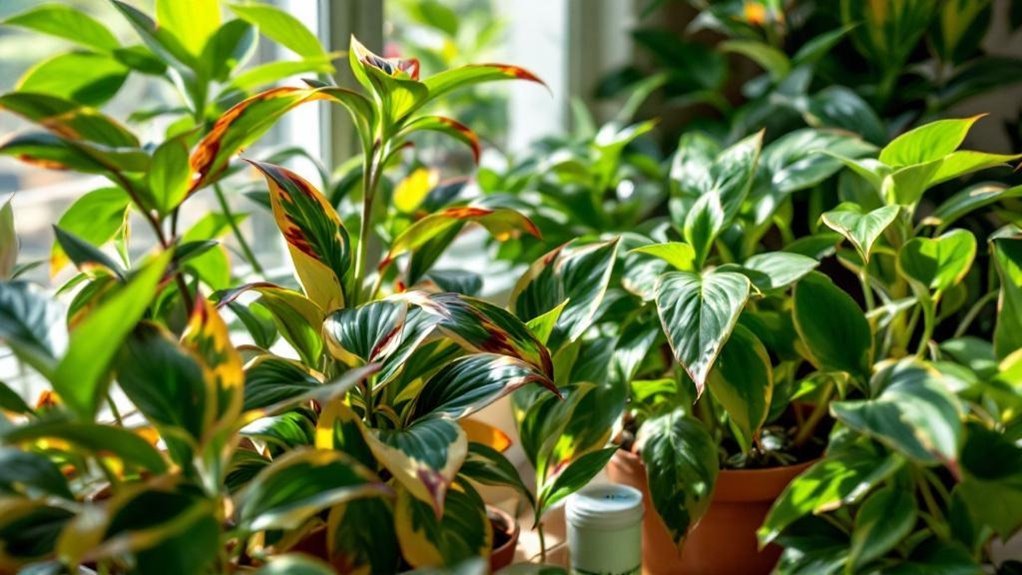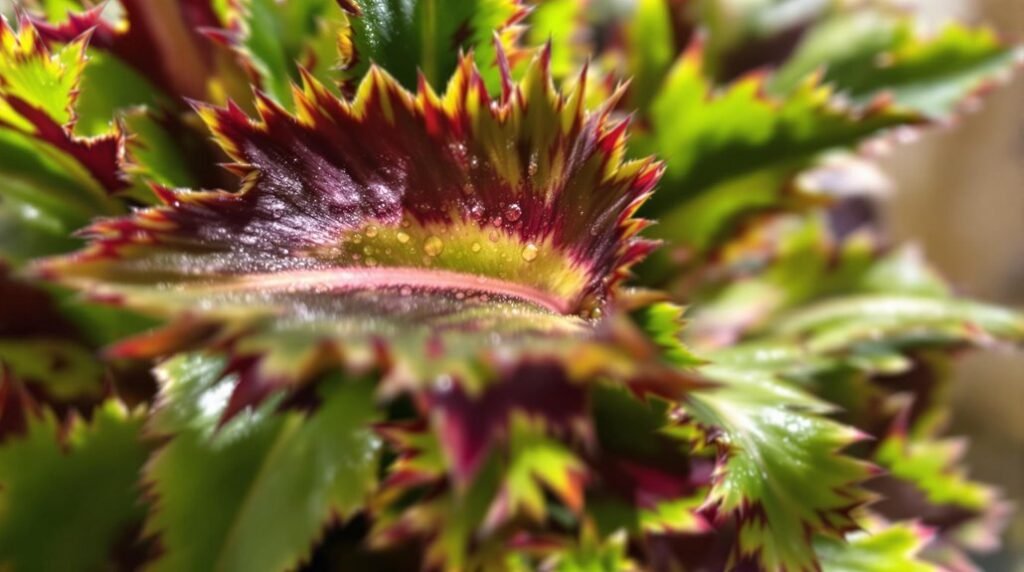You might have heard that brown leaf tips on houseplants always mean you’re underwatering, but is that really the full story? While inconsistent watering can cause damage, other factors like humidity levels, salt buildup from fertilizer, or even pests might be at play. Understanding what’s truly stressing your plant is key to fixing the problem and preventing it from returning. Let’s explore what could be causing those brown tips and how you can help your plants thrive again.
Common Causes of Brown Leaf Tips
Although brown leaf tips can occur for several reasons, inconsistent watering is one of the most common causes you’ll encounter.
Both overwatering and underwatering lead to dehydration and stress, causing those unsightly brown edges. Low humidity levels and a dry atmosphere also cause moisture loss, especially in tropical plants, worsening the browning.
Excess fertilizer creates salt buildup in the soil, damaging plant tissues and triggering brown tips. Nutrient deficiencies, particularly in potassium or nitrogen, show up as brown edges, signaling the need for proper fertilization.
Pests and diseases like spider mites or powdery mildew further contribute to these symptoms.
To keep your plants healthy, focus on consistent watering, maintain humidity, avoid over-fertilizing, and stay vigilant by monitoring plants for any signs of pests and diseases.
How to Assess Soil and Root Health
When you suspect brown leaf tips stem from soil or root issues, start by checking the soil moisture. Feel the soil; it should be cool and moist, never soggy or dry, indicating proper moisture levels.
Next, gently remove your plant from its pot to inspect the roots. Healthy roots are white and firm, while dark, mushy roots signal root rot and need immediate attention. Make sure drainage holes aren’t blocked, as poor drainage traps water, suffocating roots and causing rot.
Assess soil texture too—well-draining soil blends organic matter for air circulation and moisture retention without waterlogging. Finally, test your soil’s pH and nutrient levels regularly to catch deficiencies or toxicities that harm root function and overall plant health.
These steps help keep roots and soil in top condition.
Managing Watering and Humidity for Healthy Leaves

Since consistent watering plays a crucial role in preventing brown leaf tips, you should water your houseplants thoroughly until water drains from the pot’s bottom. This guarantees moist soil and helps avoid underwatering or overwatering, which can cause brown tips.
Poor drainage can trap excess water, depriving roots of oxygen and nutrients, so check pots for proper drainage holes. Using filtered water reduces salt buildup that harms plant leaves and triggers browning.
Ensure pots have drainage holes and use filtered water to prevent harmful salt buildup and root damage.
To maintain ideal humidity (40-60%) for indoor plants, mist leaves daily or group plants to create a humid micro-climate. You can also use a humidifier to counter dry air.
Regularly flush potting mix with water to remove salts and support nutrient uptake, promoting healthy, vibrant leaves free from brown tips.
Identifying and Addressing Salt Buildup
If your houseplant shows brown leaf tips along with a white crust on the soil or pot edges, salt buildup might be the culprit. Excess salts from over-fertilization or softened water accumulate in the potting mix, harming plant health. To address this, water thoroughly, allowing water to flow out of drainage holes, flushing out the salts.
| Indicator | Action |
|---|---|
| Brown tips on leaves | Check for salt buildup |
| White crust on soil | Flush potting mix with water |
| Frequent fertilizer | Reduce to prevent excess salts |
Using distilled water and quality potting mix helps reduce salt buildup, avoiding brown tips and promoting healthier growth. Regularly monitoring these signs guarantees your houseplants stay vibrant and thriving.
Practical Steps to Restore and Maintain Plant Health

Although brown leaf tips can signal various issues, you can restore your plant’s health by taking practical steps like maintaining consistent soil moisture, increasing humidity, and removing damaged leaves.
Regularly check soil moisture before watering to avoid underwatering or excess water. Verify water runs freely through drainage holes to prevent root rot.
Increasing humidity levels by misting or using a pebble tray helps prevent brown tips caused by dry air. Trim away brown tips with sharp scissors to promote healthy, active growth.
Flush the potting mix occasionally to remove salt buildup, and if problems persist, repot with fresh soil.
Also, inspect for insect pests, which can stress plants and cause damage. Together, these steps will help your houseplants recover and thrive.
Frequently Asked Questions
How Do You Fix Brown Tips on Houseplants?
You should trim brown tips with clean scissors, adjust your watering schedule to avoid over or underwatering, increase humidity by misting or grouping plants, and flush soil to remove salt buildup to help your houseplants recover.
Why Are the Ends of My Houseplant Leaves Turning Brown?
Imagine your plant’s leaves as candles flickering—brown tips mean the flame’s struggling. You’re likely overwatering, underwatering, or facing low humidity. Check moisture, humidity, and nutrients to revive that vibrant green glow.
What Does It Mean When the Tips of a Plant’s Leaf Are Brownish?
When your plant’s leaf tips turn brownish, it usually means they’re stressed from inconsistent watering, low humidity, excess fertilizer, nutrient deficiencies, or pests. You’ll want to check these factors to help your plant recover.
Final Thoughts
You might think those brown leaf tips are just a minor flaw, but they’re actually your plant’s way of asking for help. By checking your watering habits, boosting humidity, and watching fertilizer use, you’ll not only stop the browning but also see your plant thrive like never before. Funny how a little attention to these details can turn brown tips into vibrant growth—your plants will thank you with every healthy leaf they show.
